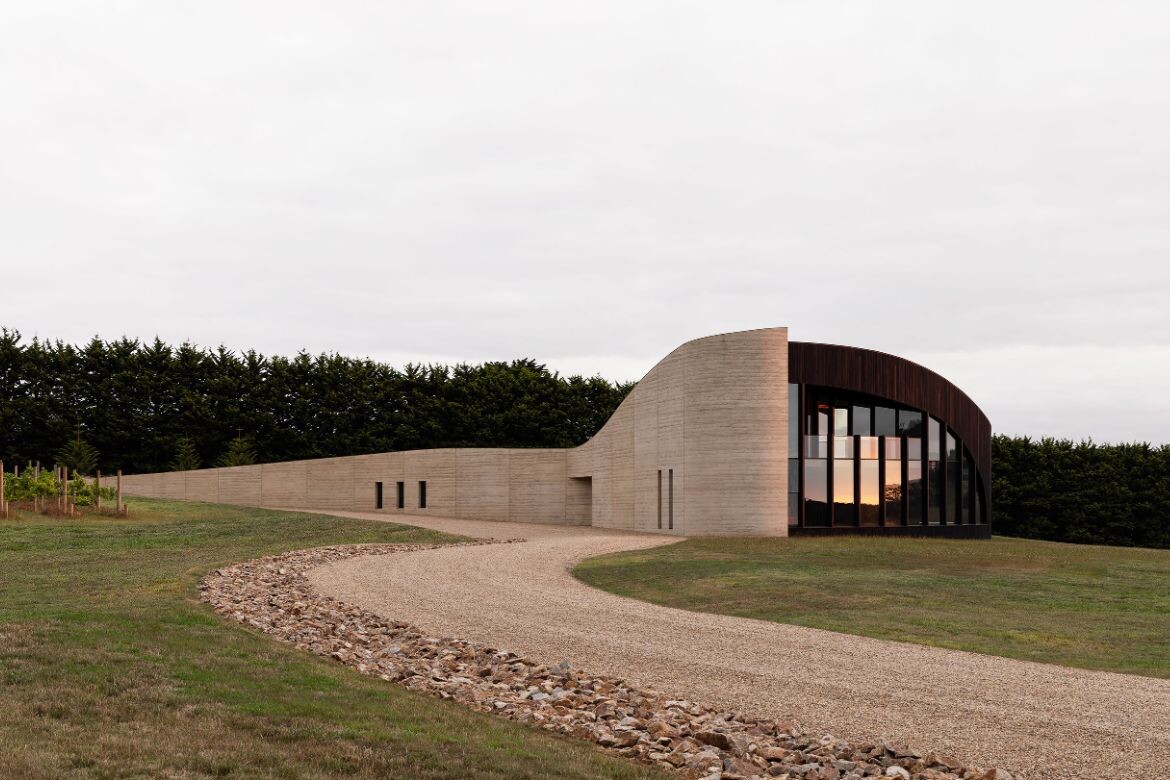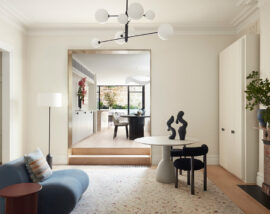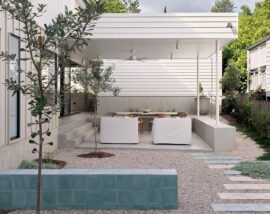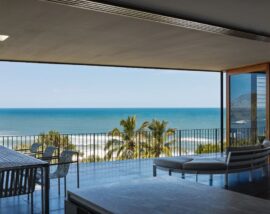Monumental, sculptural and decidedly present, Peninsula House presents as more of a nod to the practice of land art than what traditional architecture usually condones. Land art, defined as a movement with a direct engagement with nature, is about creating artworks in and with the landscape. Herein lies the language that underscores the Wood Marsh oeuvre.
Staring with the land itself, the project, as Roger Wood, principal of Wood Marsh explains, is a direct response to the intersection of rural rolling green and rugged coastal terrain.
“The house does look like it has been heaved up or extruded from the land, while the profile of the house looks like that part of the coastline of Victoria, where it is heavily eroded tertiary dune systems, prehistoric in quality,” he says.

Located on the high point of the site overlooking a coastal stretch of Flinders with Bass Strait beyond, the house is approached gently with a long curving driveway that in many ways mimics the house itself, and will be planted with Norfolk Pines. As such, the building, which right now is glimpsed in parts before revealing itself as a long sweeping curve that spills naturally from the land, will with time be more subtly disclosed.
Conceived in the round with articulating topographic contour lines, there is a visual correlation to the terraced land art of Charles Jencks’ Landform (2001). That said, the comparison is fleeting, with the building’s rammed earth mass seamlessly emerging from the landscape to unfurl, ribbon-like, to rise 10 metres into the air before wrapping behind the dwelling, and gradually tapering and returning to the landscape.
“It’s of the land. It could be a prehistoric house that was built 10 million years ago, and then covered over and through erosion, exposed again,” says Wood.

In keeping with this monumentality, a slight crease in the wall indicates the entry point: “It was almost like someone has peeled the earth back to create a recess in which to put the door. Other cultures talk about Feng shui and other mechanisms, but we find, if we just peel that back, then it’s clear where the front door is, without overstating it,” says Wood, who also points out the shelter provided when arriving during a storm.
Within this grand rammed earth wall, the home is expansive, dark and moody. Juxtaposed by the interior side of the earth wall, the tonal shifts within a black palette are articulated through textural and nuanced materiality.
Dark oxide laden polished concrete floors (with a terrazzo screed and underfloor heating) provide the foundation, while black-stained timber, black stone and tiles provide the majority of the materiality.

There is a saying, “where there is light, there must be shadow,” attributed to both Carl Jung and Haruki Murakami, and echoed in the sentiments of Junichiro Tanizaki and Juhani Pallasmaa, who understand the sensorial need for both dark and light in architecture.
At Peninsula House, the dark interior welcomes the abundance of light with corners dissolving into shadow, hallways that seemingly never end and sharply defined shards of light that cut across hallways to describe the sun’s arc.
Arranged as a three-pointed isotoxal star, the central axis is a planted atrium that floods the central portion with light.

Moreover, as the house faces Bass Strait, there are days when the exterior windows cannot be opened. “We’ve found, environmentally, that we can purge the house by having windows open there. It has a chimney effect of taking air from the house and expelling it. It refreshes. If you can’t open the main windows because of weather, then we can still get very passive ventilation throughout the house,” says Wood.
Leading from the atrium are three distinct zones: a living area for entertaining, a recreation zone and bedroom area for four guest rooms (all with exceptional views), plus the private main bedroom, which sits above the living space and is accessed by a sweeping stair cloaked in darkness. “It’s like a secret, shadowy void that you walk into, or ascend; you don’t really know where you’re going to end up. You don’t open a door to see a corridor with another door at the end. It’s an experience,” says Wood.
This is in fact true of the entire house, where curving walls and shadows conceal depths and passages. “We have tried with all these forms to make them recently temporal, of the body, rather than machine-made. There are a lot of right angles in most architecture; we’ve tended to round those corners off, and the walls flow in your direction of travel,” explains Wood.

The main double-height living space is sensationally dramatic. Fully glazed, the view across the rural terrain and ocean is stupendous, with Bass Strait’s wild storms gloriously framed.
Following the line of the earth wall, the parabolic ceiling flows seamlessly to the large curved windows. “In our work the external form and interior form of the building are one and the same for each building. We don’t like a shape on the outside, which is then fitted out internally. That’s why we expose the earth wall inside and the ceiling follows the parapet line of most of that large earth wall. So, when you’re in those interior volumes, it’s not just a flat ceiling, with walls in it, it’s three-dimensional,” says Wood.
This is beautifully apparent in the long, curving hallway of rammed earth with slot windows that leads to the building’s tail and a bespoke recording studio.

The interior moments of the home are beautifully resolved with rammed earth walls meeting black timber and curves. The kitchen for example is entirely sculptural, with an off-centre oval sitting atop an oval plinth, while the curving wall of black-battened expanse gives way to cabinetry and black mosaics.
A discrete wall within the cabinetry gives entry to a butler’s pantry and kitchen utility. In the bathrooms, the rammed earth wall is contrasted with black mosaics and a deep grey granite vanity with black timber cabinetry and round black basins. Grey tinted glass lights complete the mood.
To fulfil the client’s brief to host grand poolside events with views of the valley and water is a large, sheltered terrace. The large deck of white cypress surrounding the pool was selected for its silvering quality that will afford a monochromatic shift within the tonal composition. Soft, silvery and warm underfoot, it is a lovely embellishment to the palette that gently blurs the building’s boundary to the surrounding landscape.

The natural external material palette of charred timber and rammed earth benefits the home with robust and low-maintenance qualities. “Every surface of the building is very heavily insulated. We always look at orientation, daylight, ventilation, thermal breaks, to get our houses as close to off-grid as we can and maintain a thermal mass so the energy usage is negligible,” says Wood.
The charred battens, moreover, cloak the building mass, allowing it to recede into the rural context as an enigmatic form. This is countered by the slight green to the glazing, which reflects sky and pasture to enfold the house more fully into nature. To one side a balcony provides a setback series of glazed portions and a shift to the reflected rhythm.
On Naoshima, the inland sea island of Japan, made famous as an art island of the Benesse corporation, the Chichu museum by Tadao Ando is counted as one of the artworks. So too should this home, which, while domestic in functionality, is wholly of the land art genre with its sweeping articulation of the site. Grand, beautiful and simply extraordinary, Wood Marsh has, as always, delivered exemplar architecture of exceptional calibre.
Project details
Architecture and interiors – woodmarsh.com.au
Photography – Timothy Kaye
Location – Flinders, Victoria, Australia
Traditional Custodians – Bunurong People





























